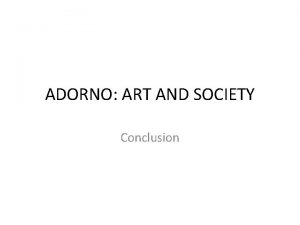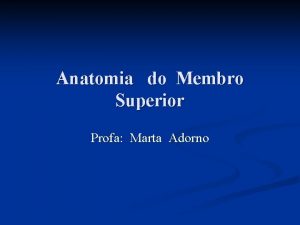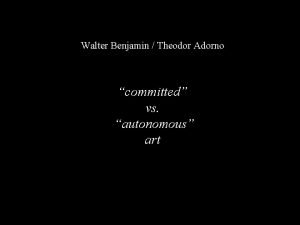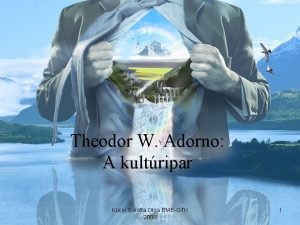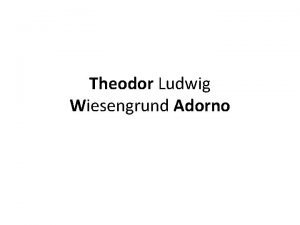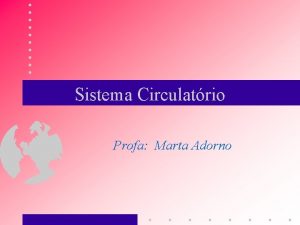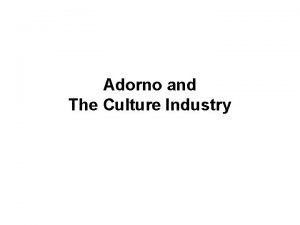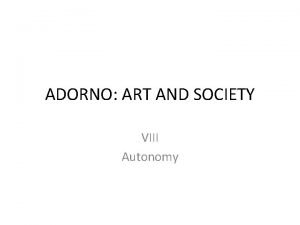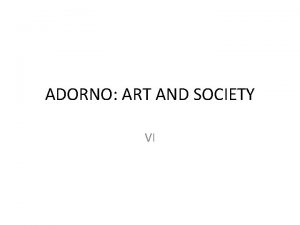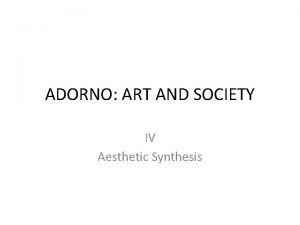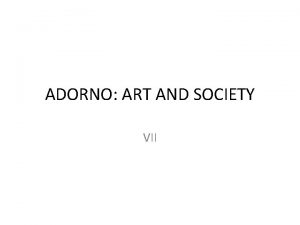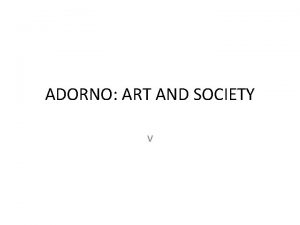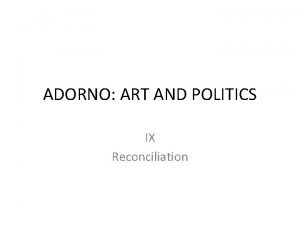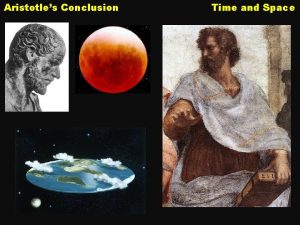ADORNO ART AND SOCIETY Conclusion Art reveals the











- Slides: 11

ADORNO: ART AND SOCIETY Conclusion

• Art reveals the true character of social reality in virtue of its unique principle of organization and at the same time points to a better, reconciled, state of society • Art is based on a nonviolent synthesis enabling the preservation of the particulars, the heterogeneous and the resulting antagonisms – thus, art is able to express what has been suppressed, muted or destroyed in social reality, mainly nature, mimesis or the non-identical

• Art is inherently opposed to the principle of (instrumental) rationality, i. e. the tendency to categorize and subordinate the particulars under a general, pre-constituted, concept, in consequence forcing unity to nonidentical phenomena and excluding their complexity • Rationality is pervaded by power, by the atrophied need for self-preservation, by instrumentality, utility and economical principles, mainly the exchange principle

• The genuine task of reason is to realize ideals of freedom, justice, equality; to enable every individual to life a good life; to lessen the suffering => this seems unlikely in current social conditions of late capitalism due to the allpervasive reification of human consciousness, dominance of an artificially manufactured needs and desires, utilitarian and manipulative attitude towards objects as well as other subjects and the repression of the inner nature and individuality of each person

• Art is resistant and simultaneously able to express the problems of social reality and rationality as its determining principle • Artworks are based on a non-violent aesthetic synthesis placing them in a direct and polemical opposition to the social organization • The aesthetic synthesis achieves a meaningful whole without subordination of the particular elements, yet every concrete element is determined by the resulting whole • The aesthetic synthesis emerges from the elements of a given artwork, it is not a rule or order placed on artworks externally

• The aesthetic synthesis is not harmonious, it reveals contrasts, tensions and antagonisms amongst the elements • Thus, the aesthetic synthesis is always unstable, precarious, dynamic – the artwork is a force field • The aesthetic synthesis is a peculiar, nonviolent, non-suppressive form of the relation of the whole and the particular

• Art is thus able to express „ that very wealth of existent which is otherwise cut off by the logic of judgement“ – most importantly nature and mimesis • Mimesis is a historical category, taking on different functions and features at different points in the history of its development (interaction with one‘s environment, intermeshed with manipulation in magic, repudiated by rationality)

• Mimesis, or mimetic behaviour, in art signifies the openness towards the particular and the freedom to the object, the imitation of that which is external to consciousness • Nature captured in the artwork is not nature as an object to be manipulated and scientifically categorized • It is nature as indeterminate, ephemeral, distant

• On the basis of the aesthetic synthesis the artwork discloses the true nature of reality, i. e. its oppressive and false character • Simultaneously, the artwork is an embodiment of reconciliation, i. e. non-violent relation of rationality and mimesis, and as such transcends the current, unsatisfying, social conditions and represents a glimpse of hope • Hence, the artwork (and the aesthetic synthesis) is always critical and at the same time utopian

• This knowledge gained from the artwork can be achieved only be a genuine aesthetic experience of the artwork • The aesthetic experience is an experience of happiness and pleasure on the one hand, but makes us aware of the suffering and of the coercive character of social reality on the other • Art is an expression of suffering and gives voice to the victims

• The truth of art is this ability of artworks to disclose, oppose and challenge the social reality and by extension, rationality as its determining principle
